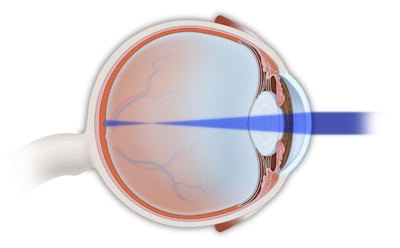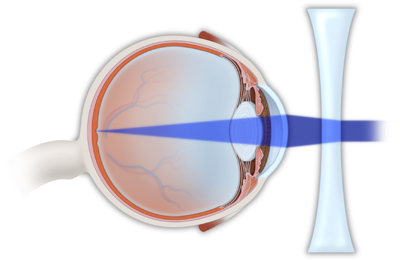Myopia / Nearsightedness
What Is Myopia / Nearsightedness?
Myopia or nearsightedness allows you to see objects close to you clearly, but objects further away will seem blurry. It is often caused by a steepening of the cornea or elongation of the eye.
The cornea is the part of the eye that helps to focus light on the retina and works similar to the lens on a camera. Light passing through the cornea is bent and focused in a process called “refraction”. Because the shape of the cornea is not perfect, the light does not always focus perfectly on the retina. This blurring and focal distortion is known as a “refractive error”. Myopia or nearsightedness is one type of refractive error.
If your cornea is almost perfectly round, it is able to focus light directly on a single spot.
However, if your cornea has a steeper curve than normal or if your eye is longer than normal, instead of focusing light on a single spot at the back of your retina, it focuses in front of the retina. This is why you are able to see objects up close more clearly, while objects further away will appear blurry.
Normally, myopia develops in childhood and stabilizes by the time we reach adulthood.
Who Is at Risk for Myopia / Nearsightedness?
The exact cause of myopia is uncertain and may include both a hereditary and environmental component. If both parents are nearsighted, then your children have a greater than average chance of developing myopia. Studies have also shown a connection between refractive errors like myopia and hyperopia in twins, thus indicating a genetic component.
Certain Asian countries, including Singapore and Taiwan, have higher rates of myopia than the estimated 25 percent of Americans who are nearsighted. For example, one in three (1/3) Singaporean children have been diagnosed with myopia in the past decade. It is thought that excessive amounts of close work and reading, particularly in dim light, as well as prolonged and frequent use of the computer, may be contributing factors.
What Are the Symptoms of Myopia / Nearsightedness?
Since myopia is usually detected in childhood, teachers may tell you that your child is having difficulty seeing the blackboard. You may notice that he or she squints when watching TV or that your child has to hold a book very close to the face to be able to read. Your child may also complain of headaches or eyestrain, particularly if they also have another focusing problem called astigmatism. Since up to two out of three (2/3) of people with myopia are also astigmatic, this would not be surprising.
Therefore, if you or your child’s teacher notices any of these symptoms, you should arrange for a comprehensive eye examination.
How Is Myopia / Nearsightedness Detected?
Myopia is detected in a comprehensive eye examination, which will include:
- Visual acuity test: Measures the ability to see at all distances
- Refraction: Uses a phoropter to measure vision correction using different strengths of optical lenses
How Is Myopia / Nearsightedness Treated?
Once myopia or nearsightedness is confirmed, your eye doctor will discuss various treatment options. For children and teens, the key to correcting nearsightedness is to utilize a lens, either through eyeglasses or contact lenses, to properly focus light on the retina.
Many adult patients whose lens prescriptions have been stable for a year consider LASIK Eye Surgery, the most advanced type of laser surgery used today to correct nearsightedness, farsightedness and astigmatism. Although these problems can be corrected with eyeglasses or contact lenses, some people become frustrated with relying on these optical solutions. If you are one of these people, LASIK surgery may be the right answer for you.
Another surgical option for certain selected adults with nearsightedness is Photorefractive Keratectomy (PRK). For patients whose corneas are too thin for LASIK, PRK is another opportunity to be less dependent on glasses and contact lenses.
An exciting new development in the surgical treatment of nearsightedness is the use of implantable collamer lenses(ICLs), which are also known as phakic intraocular lenses(IOLs). ICLs correct your vision in much the same way as contact lenses. These lenses are implanted in your eye, behind the iris. However, because your natural lens is not removed in this surgery, this procedure is reversible.
If you would like to reduce or eliminate your dependence on glasses or contact lens to correct your nearsightedness, you should discuss these options with your eye doctor.
Primary Eye Care Specialists at Kadrmas Eye Care New England
Meet our optometrists who specialize in primary eye care and general eye health:




